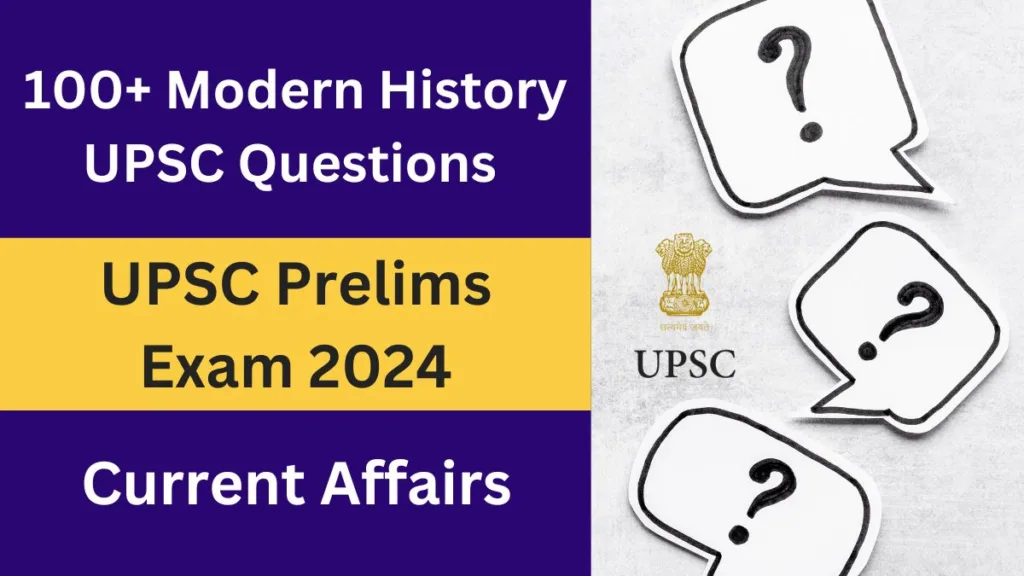Are You Preparing for the Upcoming UPSC Prelims 2024 Examination. Test Your Knowledge with these Modern History UPSC Questions and Get ahead of the competition. These Modern History UPSC questions Helps you to cover important topics for the Examination.
Modern History UPSC Questions for Preliminary Exam 2024
Who was the Governor-General of India during the Sepoy Mutiny of 1857?
a) Lord Dalhousie
b) Lord Canning
c) Lord Curzon
d) Lord Wellesley
Answer: b) Lord Canning
The first Satyagraha campaign led by Mahatma Gandhi was in:
a) Champaran
b) Dandi
c) Sabarmati
d) Bardoli
Answer: a) Champaran
The Rowlatt Act was passed in which year?
a) 1919
b) 1922
c) 1915
d) 1920
Answer: a) 1919
The doctrine of Lapse was associated with which Governor-General?
a) Lord Cornwallis
b) Lord Dalhousie
c) Lord Wellesley
d) Lord Hastings
Answer: b) Lord Dalhousie
Who was the founder of the All India Muslim League?
a) Liaquat Ali Khan
b) Aga Khan
c) Muhammad Ali Jinnah
d) Sir Syed Ahmed Khan
Answer: d) Sir Syed Ahmed Khan
The Vernacular Press Act was passed during the tenure of:
a) Lord Curzon
b) Lord Dalhousie
c) Lord Wellesley
d) Lord Lytton
Answer: a) Lord Curzon
The Montagu-Chelmsford Reforms were associated with:
a) Home Rule Movement
b) Non-Cooperation Movement
c) Government of India Act 1919
d) Quit India Movement
Answer: c) Government of India Act 1919
The Kakori Conspiracy Case is related to:
a) Bhagat Singh
b) Chandrashekhar Azad
c) Lala Lajpat Rai
d) Ram Prasad Bismil
Answer: d) Ram Prasad Bismil
The Queen’s Proclamation of 1858 marked the end of the rule of:
a) The Mughals
b) The British East India Company
c) The Marathas
d) The Sikhs
Answer: b) The British East India Company
The first Round Table Conference was held in:
a) 1929
b) 1930
c) 1931
d) 1932
Answer: c) 1931
The Swaraj Party was formed by:
a) Jawaharlal Nehru
b) Sardar Patel
c) Chittaranjan Das
d) Subhas Chandra Bose
Answer: c) Chittaranjan Das
The Wavell Plan is associated with which period?
a) Pre-Independence
b) World War I
c) World War II
d) Post-Independence
Answer: c) World War II
The Cabinet Mission Plan was related to:
a) Partition of India
b) Independence of India
c) Integration of Princely States
d) Communal Representation
Answer: b) Independence of India
The Indian National Army (INA) trials took place at:
a) Red Fort, Delhi
b) Jallianwala Bagh, Amritsar
c) Cellular Jail, Andaman
d) Parliament House, Delhi
Answer: a) Red Fort, Delhi
Who was the first woman President of the Indian National Congress?
a) Sarojini Naidu
b) Annie Besant
c) Vijaya Lakshmi Pandit
d) Kamala Nehru
Answer: b) Annie Besant
The Simon Commission was boycotted because:
a) It had all-British members
b) It recommended constitutional reforms
c) It proposed the partition of Bengal
d) It supported the demands of Indian leaders
Answer: a) It had all-British members
The Preamble of the Indian Constitution was adopted in:
a) 1947
b) 1950
c) 1952
d) 1949
Answer: b) 1950
The Poona Pact of 1932 was an agreement between:
a) Mahatma Gandhi and Ambedkar
b) Hindu and Muslim leaders
c) Gandhi and Jinnah
d) Brahmins and Non-Brahmins
Answer: a) Mahatma Gandhi and Ambedkar
The Non-Cooperation Movement was withdrawn by Mahatma Gandhi after the incident of:
a) Jallianwala Bagh
b) Chauri Chaura
c) Dandi March
d) Bardoli Satyagraha
Answer: b) Chauri Chaura
The Indian National Congress split into two factions, Extremists and Moderates, during the presidency of:
a) Dadabhai Naoroji
b) Gopal Krishna Gokhale
c) A.O. Hume
d) Bal Gangadhar Tilak
Answer: d) Bal Gangadhar Tilak
The Simon Commission was appointed in 1927 to:
a) Propose constitutional reforms
b) Review the working of the Government of India Act 1919
c) Investigate the Jallianwala Bagh massacre
d) Assess the economic impact of World War I
Answer: b) Review the working of the Government of India Act 1919
The Radcliffe Line is associated with:
a) The division of Bengal
b) The partition of Punjab
c) The creation of Haryana
d) The formation of the Indian Union
Answer: b) The partition of Punjab
The slogan “Inquilab Zindabad” was popularized by:
a) Jawaharlal Nehru
b) Subhas Chandra Bose
c) Bhagat Singh
d) Lala Lajpat Rai
Answer: c) Bhagat Singh
The Chauri Chaura incident led to the suspension of which movement led by Mahatma Gandhi?
a) Non-Cooperation Movement
b) Quit India Movement
c) Civil Disobedience Movement
d) Khilafat Movement
Answer: a) Non-Cooperation Movement
The Moplah Rebellion of 1921 occurred in which present-day Indian state?
a) Kerala
b) Karnataka
c) Tamil Nadu
d) Andhra Pradesh
Answer: a) Kerala
Who among the following leaders was not a part of the Dandi March led by Mahatma Gandhi?
a) Sarojini Naidu
b) Jawaharlal Nehru
c) Sardar Patel
d) Rajendra Prasad
Answer: b) Jawaharlal Nehru
The Rani of Jhansi Regiment, formed during World War II, was associated with:
a) Indian National Army (INA)
b) Azad Hind Fauj
c) Ghadar Party
d) Hindustan Socialist Republican Association (HSRA)
Answer: a) Indian National Army (INA)
The “August Offer” by the British government during World War II was a response to:
a) Quit India Movement
b) Cripps Mission
c) INA Trials
d) Jallianwala Bagh massacre
Answer: b) Cripps Mission
The Ilbert Bill controversy of 1883 was related to:
a) Religious rights
b) Judicial powers of Indians
c) Press freedom
d) Land revenue system
Answer: b) Judicial powers of Indians
The newspaper “Kesari” was associated with which freedom fighter?
a) Bal Gangadhar Tilak
b) Bipin Chandra Pal
c) Lala Lajpat Rai
d) Aurobindo Ghosh
Answer: a) Bal Gangadhar Tilak
The first session of the Indian National Congress was held in:
a) Bombay
b) Calcutta
c) Madras
d) Delhi
Answer: a) Bombay
The Jallianwala Bagh massacre took place in which city?
a) Lahore
b) Amritsar
c) Jalandhar
d) Ferozepur
Answer: b) Amritsar
The Champaran Satyagraha was against the exploitation of:
a) Farmers
b) Industrial workers
c) Untouchables
d) Indigo plantation workers
Answer: d) Indigo plantation workers
The “Doctrine of lapse” was first applied by:
a) Warren Hastings
b) Lord Dalhousie
c) Lord Cornwallis
d) Lord Curzon
Answer: b) Lord Dalhousie
The president of the Lahore Session of the Indian National Congress in 1929 was:
a) Jawaharlal Nehru
b) Subhas Chandra Bose
c) Sardar Patel
d) Rajendra Prasad
Answer: b) Subhas Chandra Bose
The Jallianwala Bagh National Memorial was established in the year:
a) 1915
b) 1919
c) 1922
d) 1925
Answer: b) 1919
The Cripps Mission, sent to India in 1942, proposed:
a) Complete independence for India
b) Dominion status for India after the war
c) Partition of India
d) Separate electorates for minorities
Answer: b) Dominion status for India after the war
The Young Bengal movement was associated with:
a) Ishwar Chandra Vidyasagar
b) Raja Ram Mohan Roy
c) Henry Louis Vivian Derozio
d) Swami Vivekananda
Answer: c) Henry Louis Vivian Derozio
The “Doctrine of lapse” was criticized by which Indian leader?
a) Dadabhai Naoroji
b) Raja Ram Mohan Roy
c) Ishwar Chandra Vidyasagar
d) Jawaharlal Nehru
Answer: c) Ishwar Chandra Vidyasagar
The Nagpur Session of the Indian National Congress in 1920 was significant for the launch of which movement?
a) Non-Cooperation Movement
b) Civil Disobedience Movement
c) Quit India Movement
d) Swadeshi Movement
Answer: a) Non-Cooperation Movement
The system of “Subsidiary Alliance” was introduced by:
a) Lord Dalhousie
b) Lord Cornwallis
c) Lord Wellesley
d) Lord Hastings
Answer: c) Lord Wellesley
The Rowlatt Act aimed at empowering the government to:
a) Suppress the activities of revolutionary leaders
b) Introduce land reforms
c) Provide economic relief to farmers
d) Grant political autonomy to provinces
Answer: a) Suppress the activities of revolutionary leaders
The poet who gave the slogan “Swaraj is my birthright and I shall have it” was:
a) Rabindranath Tagore
b) Subhas Chandra Bose
c) Bal Gangadhar Tilak
d) Lala Lajpat Rai
Answer: c) Bal Gangadhar Tilak
The Cabinet Mission Plan proposed the creation of how many groups of provinces in British India?
a) Two
b) Three
c) Four
d) Five
Answer: b) Three
The Kuka Movement 1872, a 19th-century Sikh socio-religious movement, originated in which region of India?
a) Punjab
b) Bengal
c) Maharashtra
d) Gujarat
Answer: a) Punjab
The Bardoli Satyagraha of 1928 was led by:
a) Sardar Patel
b) Jawaharlal Nehru
c) Rajendra Prasad
d) Subhas Chandra Bose
Answer: a) Sardar Patel
The Lucknow Pact of 1916 was signed between:
a) Indian National Congress and Muslim League
b) Indian National Congress and British Government
c) Hindu Mahasabha and Muslim League
d) Indian National Congress and Sikhs
Answer: a) Indian National Congress and Muslim League
The site of the Jallianwala Bagh massacre is now a:
a) Memorial
b) Park
c) Museum
d) Educational institution
Answer: a) Memorial
The Indian Independence Act of 1947 proposed the partition of which region?
a) Punjab
b) Bengal
c) Kashmir
d) Gujarat
Answer: b) Bengal
The Treaty of Bassein 1802 was signed between the British East India Company and which Maratha leader?
a) Rani Laxmibai
b) Nana Saheb
c) Peshwa Baji Rao II
d) Shivaji
Answer: c) Peshwa Baji Rao II
The slogan “Do or Die” was associated with which movement led by Mahatma Gandhi?
a) Non-Cooperation Movement
b) Quit India Movement
c) Civil Disobedience Movement
d) Swadeshi Movement
Answer: b) Quit India Movement
The Jallianwala Bagh National Memorial Act was passed in which year?
a) 1919
b) 1947
c) 1951
d) 1961
Answer: c) 1951
The Bengal Partition was annulled in which year?
a) 1911
b) 1919
c) 1947
d) 1956
Answer: a) 1911
The famous Indian leader who was known as the “Grand Old Man of India” was:
a) Dadabhai Naoroji
b) Gopal Krishna Gokhale
c) Bal Gangadhar Tilak
d) Jawaharlal Nehru
Answer: a) Dadabhai Naoroji
The Non-Cooperation Movement was launched after the:
a) Jallianwala Bagh massacre
b) Khilafat Movement
c) Champaran Satyagraha
d) Simon Commission
Answer: b) Khilafat Movement
The Indian National Congress passed the resolution for complete independence (Purna Swaraj) in which year?
a) 1929
b) 1930
c) 1931
d) 1932
Answer: a) 1929
The first Indian to become the President of the International Congress was:
a) Jawaharlal Nehru
b) Subhas Chandra Bose
c) Sardar Patel
d) Rajendra Prasad
Answer: b) Subhas Chandra Bose
The Champaran Satyagraha was aimed at protesting against the exploitation of:
a) Industrial workers
b) Farmers
c) Untouchables
d) Mine laborers
Answer: b) Farmers
The Rowlatt Act was passed during the tenure of which Viceroy of India?
a) Lord Curzon
b) Lord Ripon
c) Lord Chelmsford
d) Lord Reading
Answer: c) Lord Chelmsford
The Indian National Congress split into two factions, the Moderates and the Extremists, during the presidency of:
a) Dadabhai Naoroji
b) Gopal Krishna Gokhale
c) A.O. Hume
d) Bal Gangadhar Tilak
Answer: b) Gopal Krishna Gokhale
The Permanent Settlement, also known as the Zamindari System, was introduced by
a) Lord Cornwallis
b) Lord Wellesley
c) Lord Dalhousie
d) Lord Mountbatten
Answer: a) Lord Cornwallis
My name is Mohit sharma I am a Professional content writer having experience in Digital marketing. I write latest content related to Technology and business.


